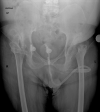Bilateral Knee Arthrodesis and Total Hip Arthroplasty for Knee and Hip Dysplasia Secondary to Spina Bifida: A Case Report
- PMID: 38784872
- PMCID: PMC11111242
- DOI: 10.13107/jocr.2024.v14.i05.4440
Bilateral Knee Arthrodesis and Total Hip Arthroplasty for Knee and Hip Dysplasia Secondary to Spina Bifida: A Case Report
Abstract
Introduction: Spina bifida is a rare neurological condition that, if uncorrected, may cause chronic valgus knee stress difficulty with independent ambulation and significant pain. Current literature lacks comprehensive guidance on surgically correcting progressive hip and knee deformities in spina bifida patients, which include osteotomy and primary. When these options are contraindicated, alternative approaches such as arthrodesis may be indicated, although they remain understudied in this population.
Case report: A 47-year-old man presented with bilateral hip and knee pain. Radiographs demonstrated valgus knee deformities with severe arthrosis and bilateral femoral head subluxation. The patient had a history of spina bifida with chronic lower extremity weakness and neurogenic bladder. He underwent staged bilateral instrumented knee arthrodesis and staged bilateral total hip arthroplasty (THA).
Conclusion: This is the first reported case of bilateral instrumented knee arthrodesis in a patient with spina bifida. Orthopedic care of these patients is complex. Surgical correction of symptomatic knee and hip deformities through instrumented arthrodesis and THA may permit an improved functional outcome.
Keywords: Spina bifida; instrumented knee arthrodesis; total hip arthroplasty.
Copyright: © Indian Orthopaedic Research Group.
Conflict of interest statement
Conflict of Interest: Nil
Figures




References
-
- Feeley BT, Ip TC, Otsuka NY. Skeletal maturity in myelomeningocele. J Pediatr Orthop. 2003;23:718–21. - PubMed
-
- Parker SE, Mai CT, Canfield MA, Rickard R, Wang Y, Meyer RE, et al. Updated national birth prevalence estimates for selected birth defects in the United States, 2004-2006. Birth Defects Res A Clin Mol Teratol. 2010;88:1008–16. - PubMed
-
- Centers for Disease Control and Prevention (CDC). Racial/ethnic differences in the birth prevalence of spina bifida-United States, 1995-2005. MMWR Morb Mortal Wkly Rep. 2009;57:1409–13. - PubMed
-
- Selber P, Dias L. Sacral-level myelomeningocele:Long-term outcome in adults. J Pediatr Orthop. 1998;18:423–7. - PubMed
-
- Jobe AH. Fetal surgery for myelomeningocele. N Engl J Med. 2002;347:230–1. - PubMed
Publication types
LinkOut - more resources
Full Text Sources
